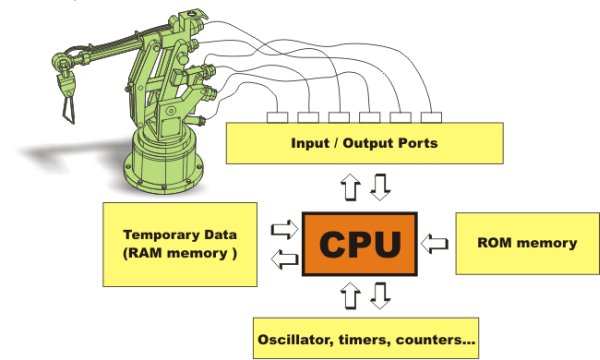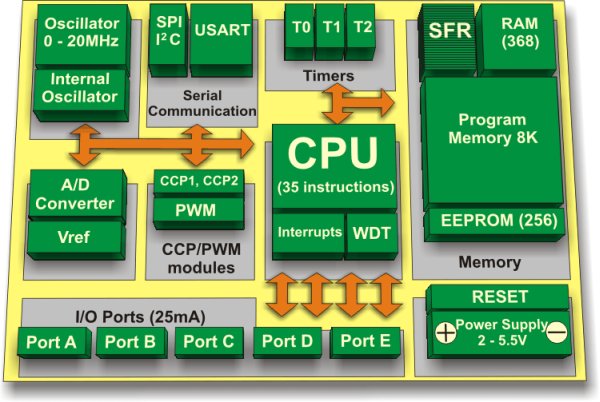Summary of Chapter 1: PIC16F887 Microcontroller – Device Overview
The article provides an overview of the PIC16F887 microcontroller from Microchip, highlighting its key features such as RISC architecture with only 35 instructions, operation up to 20 MHz, precision internal oscillator, low power consumption, various power-saving modes, and versatile I/O pins. It includes 8K flash memory, 256 bytes EEPROM, 368 bytes RAM, 10-bit 14-channel A/D converter, timers, watchdog timer, comparators, PWM control, USART supporting multiple protocols, and MSSP supporting SPI and I2C. The multifunctional pins enable compact design but only one function per pin is usable at a time.
Parts used in the PIC16F887 Microcontroller Overview:
- PIC16F887 Microcontroller (PDIP 40 pin package)
- Quartz crystal oscillator (up to 20 MHz)
- Flash memory (8K bytes)
- EEPROM memory (256 bytes)
- RAM memory (368 bytes)
- 10-bit 14-channel A/D converter
- Three timers/counters
- Watchdog timer
- Analogue comparators (two units)
- Fixed and programmable voltage references
- PWM output module
- Enhanced USART module (RS-485, RS-232, LIN2.0 support)
- Master Synchronous Serial Port (MSSP) supporting SPI and I2C modes
- Individual programmable pull-up resistors for I/O pins
- Interrupt-on-Change pins
The PIC16F887 is one of the latest products from Microchip. It features all the components which modern microcontrollers normally have. For its low price, wide range of application, high quality and easy availability, it is an ideal solution in applications such as: the control of different processes in industry, machine control devices, measurement of different values etc. Some of its main features are listed below.
- RISC architecture
- Only 35 instructions to learn
- All single-cycle instructions except branches
- Operating frequency 0-20 MHz
- Precision internal oscillator
- Factory calibrated
- Software selectable frequency range of 8MHz to 31KHz
- Power supply voltage 2.0-5.5V
- Consumption: 220uA (2.0V, 4MHz), 11uA (2.0 V, 32 KHz) 50nA (stand-by mode)
- Power-Saving Sleep Mode
- Brown-out Reset (BOR) with software control option
- 35 input/output pins
- High current source/sink for direct LED drive
- software and individually programmable pull-up resistor
- Interrupt-on-Change pin
- 8K ROM memory in FLASH technology
- Chip can be reprogrammed up to 100.000 times
- In-Circuit Serial Programming Option
- Chip can be programmed even embedded in the target device
- 256 bytes EEPROM memory
- Data can be written more than 1.000.000 times
- 368 bytes RAM memory
- A/D converter:
- 14-channels
- 10-bit resolution
- 3 independent timers/counters
- Watch-dog timer
- Analogue comparator module with
- Two analogue comparators
- Fixed voltage reference (0.6V)
- Programmable on-chip voltage reference
- PWM output steering control
- Enhanced USART module
- Supports RS-485, RS-232 and LIN2.0
- Auto-Baud Detect
- Master Synchronous Serial Port (MSSP)
- supports SPI and I2C mode
Pin Description
As seen in Fig. 1-1 above, the most pins are multi-functional. For example, designator RA3/AN3/Vref+/C1IN+ for the fifth pin specifies the following functions:
- RA3 Port A third digital input/output
- AN3 Third analog input
- Vref+ Positive voltage reference
- C1IN+ Comparator C1positive input
This small trick is often used because it makes the microcontroller package more compact without affecting its functionality. These various pin functions cannot be used simultaneously, but can be changed at any point during operation.
The following tables, refer to the PDIP 40 microcontroller.
Central Processor Unit (CPU)
I’m not going to bore you with the operation of the CPU at this stage, however it is important to state that the CPU is manufactured with in RISC technology an important factor when deciding which microprocessor to use.
RISC Reduced Instruction Set Computer, gives the PIC16F887 two great advantages:
- The CPU can recognizes only 35 simple instructions (In order to program some other microcontrollers it is necessary to know more than 200 instructions by heart).
- The execution time is the same for all instructions except two and lasts 4 clock cycles (oscillator frequency is stabilized by a quartz crystal). The Jump and Branch instructions execution time is 2 clock cycles. It means that if the microcontroller’s operating speed is 20MHz, execution time of each instruc tion will be 200nS, i.e. the program will be executed at the speed of 5 million instructions per second!
For more detail: Chapter 1: PIC16F887 Microcontroller – Device Overview
